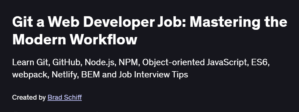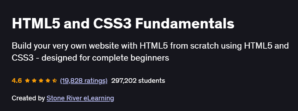What will you learn in Building Full-Stack Web Applications With Node.js and React Course
Architect and implement RESTful APIs with Node.js, Express, and MongoDB
Build dynamic front-ends using React, React Router, and Redux for state management
Connect front-end and back-end via asynchronous HTTP calls and real-time WebSockets
Secure your application with JWT authentication, role-based access control, and robust input validation
Deploy and containerize your full-stack app using Docker, CI/CD pipelines, and serverless functions
Program Overview
Module 1: Project Setup & Node.js Fundamentals
⏳ 1 week
Topics: Node.js runtime, npm/Yarn, ES6+ syntax, Express.js basics
Hands-on: Scaffold a new project, install dependencies, and build your first Express server
Module 2: RESTful APIs with Express & MongoDB
⏳ 1 week
Topics: CRUD routes, Mongoose schemas/models, query filtering, pagination
Hands-on: Create user and product endpoints, test them with Postman
Module 3: Authentication & Authorization
⏳ 1 week
Topics: JWTs, password hashing with bcrypt, middleware patterns, role checks
Hands-on: Implement signup/login flows, protect routes, and enforce admin vs. user permissions
Module 4: React Front-End Foundations
⏳ 1 week
Topics: JSX, functional components, React Hooks (
useState,useEffect), conditional renderingHands-on: Build a responsive UI to consume your REST API
Module 5: State Management & Routing
⏳ 1 week
Topics: React Router for client-side navigation, Redux for global state, async thunks
Hands-on: Wire up protected routes and manage auth state in Redux
Module 6: Real-Time with WebSockets
⏳ 1 week
Topics:
socket.iosetup on server and client, event broadcasting, roomsHands-on: Add a live chat or notification feed to your app
Module 7: Testing & Validation
⏳ 1 week
Topics: Jest and React Testing Library, API input validation with Joi, centralized error handling
Hands-on: Write unit and integration tests for both back-end endpoints and front-end components
Module 8: Deployment & DevOps
⏳ 1 week
Topics: Dockerfile & Docker Compose, CI/CD with GitHub Actions, environment configurations, AWS Lambda basics
Hands-on: Containerize your app, set up automated build/test/deploy pipeline, deploy to a cloud provider
Get certificate
Job Outlook
Full-stack JavaScript developers are in high demand across startups and enterprise teams
Roles include Full-Stack Developer, MERN Stack Engineer, and Solutions Architect
Salaries range from $95,000 to $150,000+ based on experience and geography
Mastery of Node.js and React, along with DevOps practices, positions you for leadership in modern web engineering
Specification: Building Full-Stack Web Applications With Node.js and React
|
FAQs
- Basic familiarity with JavaScript is helpful but not strictly required.
- The course introduces Node.js backend and React frontend concepts step by step.
- Beginners can follow along with hands-on exercises and projects.
- Prior experience in web development may accelerate learning, but it’s not mandatory.
- By the end, learners can build full-stack applications integrating frontend and backend effectively.
- Yes, the course teaches creating RESTful APIs using Node.js and Express.js.
- Learners practice handling HTTP requests, routing, and CRUD operations.
- Integration with databases like MongoDB is included for dynamic data management.
- Error handling and best practices for API development are discussed.
- Advanced backend features like authentication or scaling may require additional learning.
- Yes, the course covers building interactive React components and responsive layouts.
- Learners practice using JSX, state management, props, and hooks.
- Integration with backend APIs ensures dynamic data rendering in real applications.
- Projects include real-world UI/UX patterns for web applications.
- Advanced React concepts like context API or Redux may require further study.
- Yes, connecting Node.js APIs with React frontends is a key focus of the course.
- Learners practice fetching, displaying, and updating data in real-time.
- Techniques include handling asynchronous calls, API integration, and state updates.
- Hands-on projects demonstrate full-stack workflows from client to server.
- More advanced integration scenarios may require additional practice or tools.
- Yes, the course introduces deployment concepts for making applications live.
- Learners practice hosting backend and frontend applications on cloud platforms or servers.
- Guidance includes environment configuration, database connection, and domain setup.
- Deploying projects helps showcase skills for portfolios or real-world usage.
- Advanced deployment strategies like CI/CD pipelines or containerization may require further learning.





